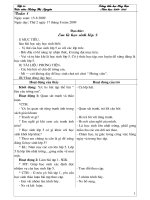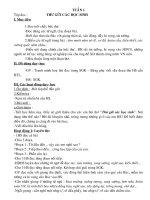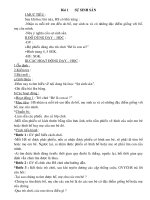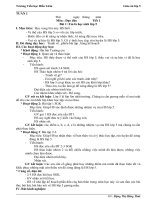- Trang chủ >>
- Mầm non - Tiểu học >>
- Lớp 5
5 1 4 famous women athletes TG
Bạn đang xem bản rút gọn của tài liệu. Xem và tải ngay bản đầy đủ của tài liệu tại đây (118.01 KB, 4 trang )
Famous Women
Athletes
SUMMARY
This book highlights women who
have broken gender and race barriers in the
field of sports.
LESSON VOCABULARY
confidence
mocking
unique
windup
fastball
outfield
weakness
INTRODUCE THE BOOK
INTRODUCE THE TITLE AND AUTHOR Discuss
with
students the title and the author of Famous
Women Athletes. Have students look at the
cover and ask them what they think they might
learn from this book. What tells them that this
will be a nonfiction book? (the Biography label)
Does the photo peak students’ interest in the
book and make them want to read more? Why
or why not?
BUILD BACKGROUND Invite students to name
famous women athletes. Ask them whether
they think women in the past had the same
opportunity to play sports as men. What are
they basing their knowledge on? Do they think
that girls and women today have the same
athletic opportunities as boys and men?
PREVIEW/USE TEXT FEATURES
Have students
look at the features in the book before
reading. What kind of art is used? (photos)
Why do they think photos are used in this
book? Point out the headings. What can
students learn from the headings? (the names
of the women and their sports) Remind them
that reading the captions will give them
important information about the women.
24
5.1.4
SEQUENCE
ASK QUESTIONS
READ THE BOOK
SET PURPOSE
Have students set a purpose for
reading Famous Women Athletes. Students’
interest in sports, women’s sports, and
history should determine this purpose. Remind
students that women’s sports have changed
over the years. Suggest that students think
about why that happened and who helped
make those changes.
STRATEGY SUPPORT: ASK QUESTIONS Revisit
how
asking questions before and during reading
can help keep the reader engaged with the
text. Then discuss how asking questions
after reading can also help students check
comprehension and solidify what they’ve
learned. For example: What did I learn about
women’s sports that I didn’t know before?
COMPREHENSION QUESTIONS
PAGE 5
How many times did Trudy attempt to
swim the English Channel? (two)
PAGES 8–9 What questions does the information on these pages answer about women and
baseball? (Responses will vary.)
PAGES 16–18
How was Rosemary Casals
different than other women tennis players?
(Possible response: Hispanic, poor, wore
colorful clothes)
PAGE 18
Which two women worked together for
the rights of female tennis players? (Rosemary
Casals and Billy Jean King)
Famous Women Athletes
16917_LRD_TG_024-025 24
1/11/06 3:10:44 PM
REVISIT THE BOOK
READER RESPONSE
1. Gertrude Ederle swims...; Althea Gibson
qualifies...; Toni Stone gets a hit...; Roberta
Gibb runs...; Billie Jean helps...
2. Possible response: Was the official following
anyone’s orders when he tried to drag her
away?
3. Possible responses: universe, unit, uniform;
sentences will vary.
4. Responses will vary.
EXTEND UNDERSTANDING
Discuss the following
with students: What kinds of photos are in
this book? Are they mostly action shots or of
people standing still? How do these photos
help you understand the written text? Have
students each pick a photo and describe in
their own words what they see.
RESPONSE OPTIONS
WRITING/VIEWING Challenge students to design
promotional posters for one of the sporting
events mentioned in this book.
SOCIAL STUDIES
CONNECTION
Have students pick one
of the women from this
book or any accomplished
female sports figure. Ask them to
use class books, the library, or the Internet
to find out more information on their subject.
Encourage students to discuss why they
picked a particular person.
Skill Work
TEACH/REVIEW VOCABULARY
Divide the group into teams. Play a quick
game where students take turns giving
definitions of the words while the rest of the
team guesses the words. Whichever team
guesses the correct word first, wins.
Students might not be familiar with
some of the sports terminology. Review
outfield, windup, and fastball, as well as
croquet, and badminton (page 3), and bunt
(page 8).
TARGET SKILL AND STRATEGY
SEQUENCE Remind students that
sequence means the order in which things
happen. Point out that the information in
this book tracks women’s accomplishments
in sports throughout the twentieth century.
Suggest students take notes as they read to
help them keep track of all the “firsts” that
these women achieved.
ASK QUESTIONS Review that asking
questions before, during, and after reading
will help students focus and comprehend
the text. Students can generate questions
to help them focus on and keep track of
the sequence of events that take place in
the history of women’s sports. Tell students
that as they read, they should write down
a couple of questions they want answered.
For example, when they get to the section
on women’s baseball, they might ask:
When was the first women’s baseball league
established? What events caused the league
to finally shut down?
ADDITIONAL SKILL INSTRUCTION
COMPARE AND CONTRAST
Remind students
that to compare and contrast things means
to look for how they are alike and different.
Students can compare information in the
book to their own knowledge; they should
also pay attention to the comparisons
and contrasts that the author makes.
Tell students that as they read, they can
compare women’s sports of the past to what
they know of women’s sports today.
Famous Women Athletes
16917_LRD_TG_024-025 25
25
12/28/05 12:59:24 PM
Name
Famous Women Athletes
Sequence
• Sequence is the order in which things happen.
Directions Answer the questions on the lines below.
1. What sport did Babe Didrikson concentrate on after winning gold medals at the
1932 Olympics?
2. What event caused Phil Wrigley to set up the All-American Baseball league?
3. Why was that event the cause?
4. Who was the first woman to play on a men’s big league team?
6. How did the events caused by Katherine Switzer help lead women to run in the
Boston Marathon?
© Pearson Education 5
5. Why did the manager sign her up?
26
16917_LRD_TG_026-027 1
12/28/05 12:59:52 PM
Famous Women Athletes
Name
Vocabulary
Directions Which vocabulary words are compound words? Write a definition for each word you list.
Check the Words You Know
confidence
outfield
windup
fastball
unique
mocking
weakness
1.
Directions Match each of the words to its antonym, or opposite meaning.
2. confidence
strength
3. unique
ordinary
4. weakness
doubt
Directions Write the definition for the word mocking.
© Pearson Education 5
5.
Directions Choose three vocabulary words and use each in a sentence below.
6.
7.
8.
27
16917_LRD_TG_026-027 2
12/28/05 12:59:53 PM









